
eBook - ePub
Introducing Game Theory
A Graphic Guide
Ivan Pastine, Tuvana Pastine, Tom Humberstone
This is a test
Buch teilen
- English
- ePUB (handyfreundlich)
- Über iOS und Android verfügbar
eBook - ePub
Introducing Game Theory
A Graphic Guide
Ivan Pastine, Tuvana Pastine, Tom Humberstone
Angaben zum Buch
Buchvorschau
Inhaltsverzeichnis
Quellenangaben
Über dieses Buch
When should you adopt an aggressive business strategy? How do we make decisions when we don't have all the information? What makes international environmental cooperation possible? Game theory is the study of how we make a decision when the outcome of our moves depends on the decisions of someone else. Economists Ivan and Tuvana Pastine explain why, in these situations, we sometimes cooperate, sometimes clash, and sometimes act in a way that seems completely random.Stylishly brought to life by award-winning cartoonist Tom Humberstone, Game Theory will help readers understand behaviour in everything from our social lives to business, global politics to evolutionary biology. It provides a thrilling new perspective on the world we live in.
Häufig gestellte Fragen
Wie kann ich mein Abo kündigen?
Gehe einfach zum Kontobereich in den Einstellungen und klicke auf „Abo kündigen“ – ganz einfach. Nachdem du gekündigt hast, bleibt deine Mitgliedschaft für den verbleibenden Abozeitraum, den du bereits bezahlt hast, aktiv. Mehr Informationen hier.
(Wie) Kann ich Bücher herunterladen?
Derzeit stehen all unsere auf Mobilgeräte reagierenden ePub-Bücher zum Download über die App zur Verfügung. Die meisten unserer PDFs stehen ebenfalls zum Download bereit; wir arbeiten daran, auch die übrigen PDFs zum Download anzubieten, bei denen dies aktuell noch nicht möglich ist. Weitere Informationen hier.
Welcher Unterschied besteht bei den Preisen zwischen den Aboplänen?
Mit beiden Aboplänen erhältst du vollen Zugang zur Bibliothek und allen Funktionen von Perlego. Die einzigen Unterschiede bestehen im Preis und dem Abozeitraum: Mit dem Jahresabo sparst du auf 12 Monate gerechnet im Vergleich zum Monatsabo rund 30 %.
Was ist Perlego?
Wir sind ein Online-Abodienst für Lehrbücher, bei dem du für weniger als den Preis eines einzelnen Buches pro Monat Zugang zu einer ganzen Online-Bibliothek erhältst. Mit über 1 Million Büchern zu über 1.000 verschiedenen Themen haben wir bestimmt alles, was du brauchst! Weitere Informationen hier.
Unterstützt Perlego Text-zu-Sprache?
Achte auf das Symbol zum Vorlesen in deinem nächsten Buch, um zu sehen, ob du es dir auch anhören kannst. Bei diesem Tool wird dir Text laut vorgelesen, wobei der Text beim Vorlesen auch grafisch hervorgehoben wird. Du kannst das Vorlesen jederzeit anhalten, beschleunigen und verlangsamen. Weitere Informationen hier.
Ist Introducing Game Theory als Online-PDF/ePub verfügbar?
Ja, du hast Zugang zu Introducing Game Theory von Ivan Pastine, Tuvana Pastine, Tom Humberstone im PDF- und/oder ePub-Format sowie zu anderen beliebten Büchern aus Matematica & Teoria del gioco. Aus unserem Katalog stehen dir über 1 Million Bücher zur Verfügung.
Information
Thema
MatematicaThema
Teoria del giocoWhat is game theory?
Game theory is a set of tools used to help analyze situations where an individual’s best course of action depends on what others do or are expected to do. Game theory allows us to understand how people act in situations where they are interconnected.
Connections between people arise in all sorts of situations. Sometimes through cooperation with others we can achieve more than we can on our own. Other times conflict arises where an individual benefits at the expense of others. And in many situations, there are benefits to cooperation but elements of conflict also exist.

We only win when we work together, but right now everybody is trying to be the star.
Because game theory can help analyze any environment where a person’s best action depends on others’ behaviour, it has proven useful in a wide variety of fields.
In economics, the decisions of firms are affected by their expectations of a competitor’s choice of product, price and advertising.
In political science, a candidate’s policy platform is influenced by the policy announcements of their rival.
In biology, animals must compete for scarce resources, but can be hurt if they are too aggressive with the wrong rival.
In computer science, networked computers compete for bandwidth.
In sociology, public displays of non-conformist attitudes are influenced by others’ behaviour, which is shaped by social culture.
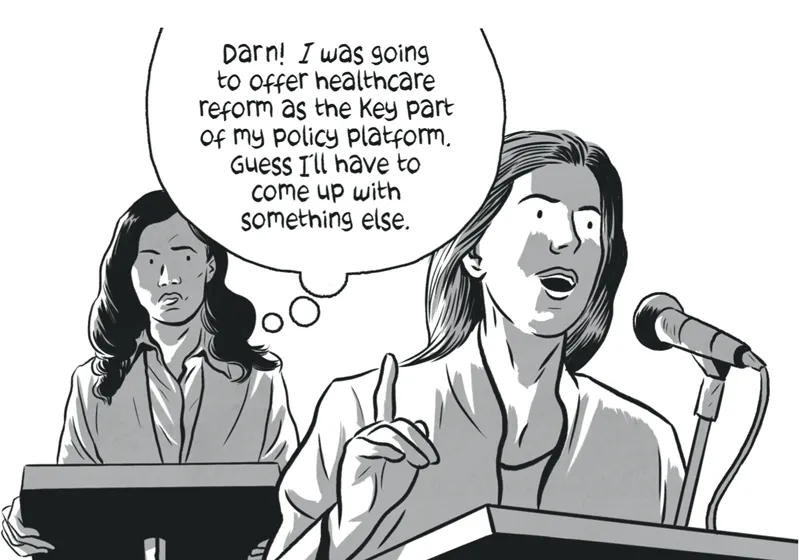
Darn! I was going to offer healthcare reform as the Key part of my policy platform. Guess I’ll have to come up with something else.
Game theory is useful whenever there is strategic interaction, whenever how well you do depends on the actions of others as well as your own choices. In these cases, people’s actions are influenced by their expectations of others’ actions.
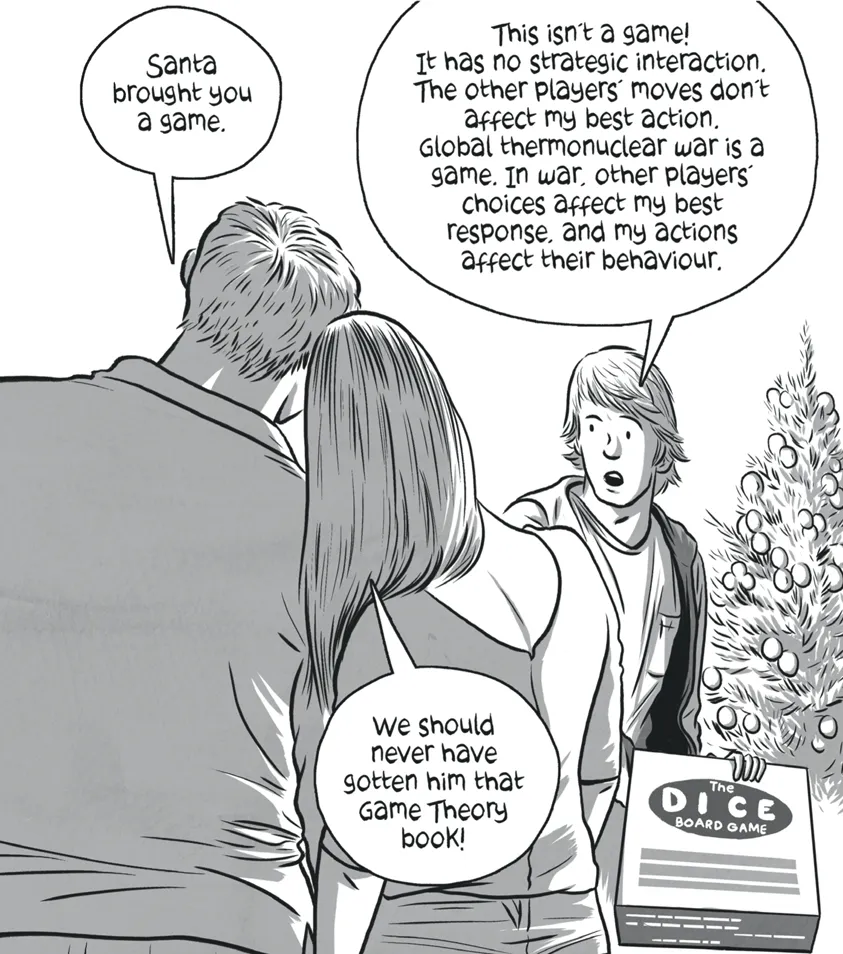
Santa brought you a game. This isn’t a game! It has no strategic interaction. The other players moves don’t affect my best action. Global thermonuclear war is a game. In war. other players’ choices affect my best response, and my actions affect their behaviour. we should never have sotten him that Game Theory book!
Why is it called “game theory”?
Game theory is the study of strategic interaction. Strategic interaction is also the key element of most board games, which is where it gets its name. Your decision affects the other player’s actions and vice versa. Much of the jargon of game theory is borrowed directly from games. The decision makers are called players. Players make a move when they make a decision.
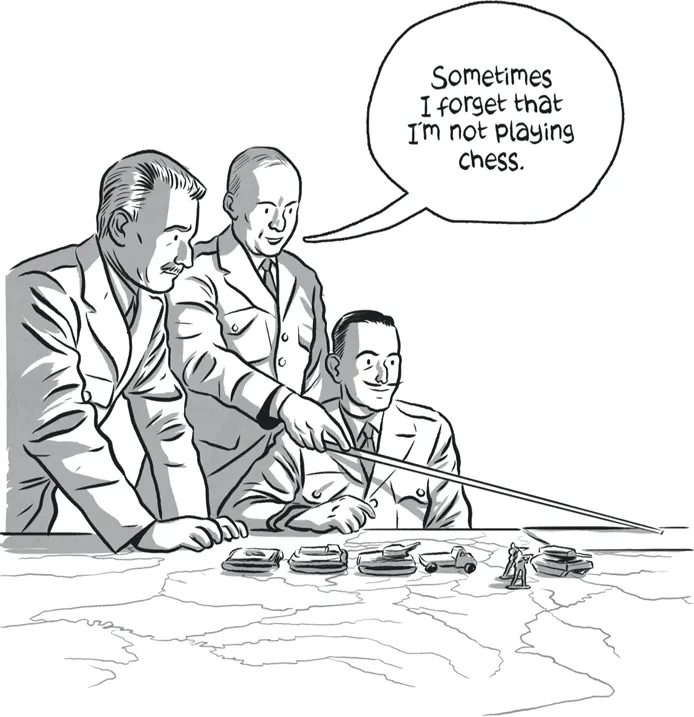
Sometimes I forget that I’m not playing chess.
Working with models
Real-world strategic interaction can be very complicated. In human interaction, for instance, it’s not just our decisions, but also our expressions, our tone of voice and our body language that influence others. People bring different histories and points of view to their dealings with others. This infinite variety can create very complex situations that are difficult to analyze.
We can circumvent this complexity by creating simplistic structures, called models. Models are simple enough to analyze but still capture some important feature of the real-world problem. A cleverly chosen simple model can help us learn something useful about the complex real-world problem.
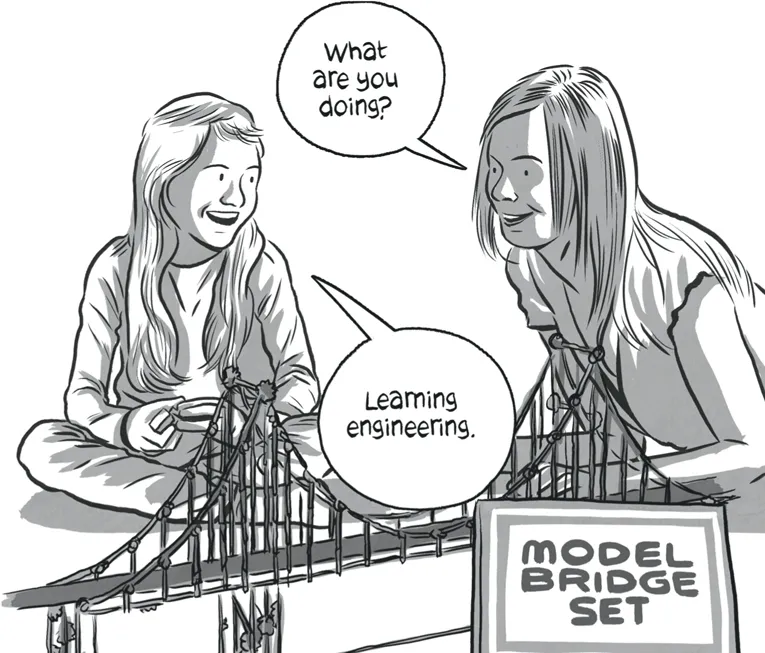
what are you doing? Learning engineering.
The game of chess is useful for understanding the complexity that variation brings to playing (and to predicting) games and outcomes. There are well-defined rules in chess. There are a limited number of options in each move. Yet the complexity of the game is daunting even though it is much simpler than even the most basic human interaction.
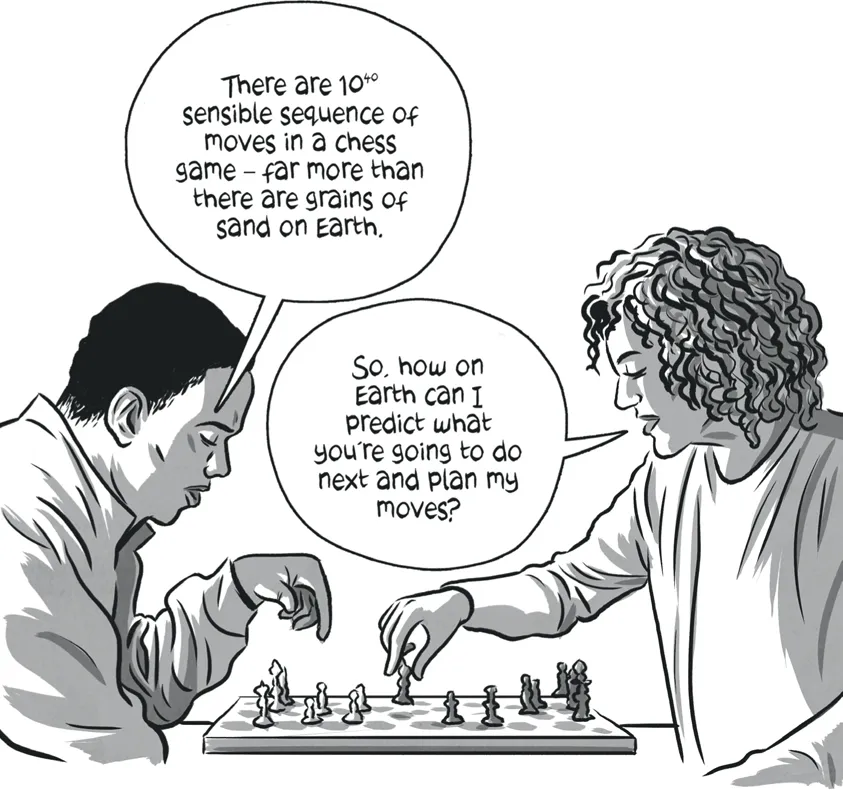
There are 1040 sensible sequence of moves in a chess game – far more than there are grains of sand on Earth. So how on Earth can I predict what you’re soins to do next and plan my moves?
“It’s a draw.”
One feature of complex board games like chess is that the more skilled the players are, the more frequently the game ends with a draw. How can we explain this observation?
Since chess itself is too complex to fully analyze, let’s use a simple model that captures some of the important features of the chess game: noughts & crosses (tic-tac-toe). Both chess and noughts & crosses have well-defined boards and victory conditions. Players take turns making choices from a limited selection of possible moves.
There is quite a lot going on in chess that is not captured by noughts & crosses. But because the two games share some important features, noughts & crosses can help improve our understanding of why skilled players tend to end the game with a draw.
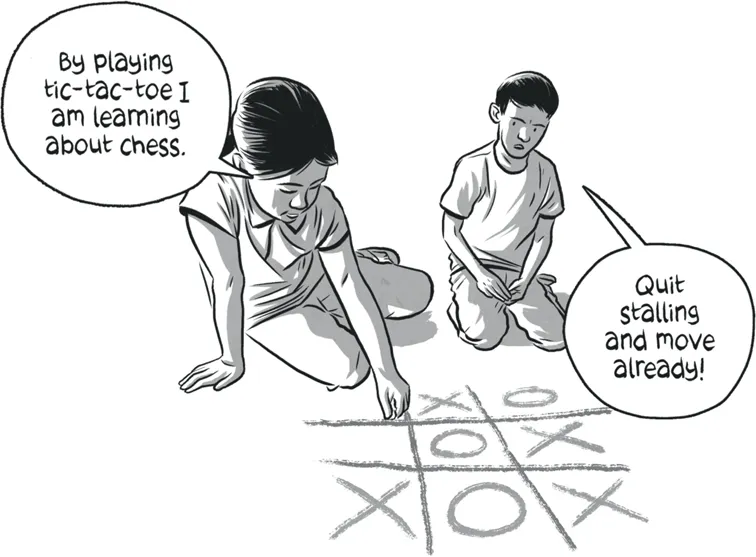
By playing tic-tac-toe I an learning about chess. Quit Stalling and move already!
Noughts & crosses is fun for small children. While the game between unskilled players tends to have a victor, after a bit of practice you quickly learn to reason via backward induction: you can figure out your opponent’s response to your possible actions and take that into consideration before making your own move.
Once players learn to reason via backward induction, all noughts & crosses games are likely to end in a draw. In this way, noughts & crosses works as a simple model of chess, in which there are far more possible moves, but which, when played between skilled players is also likely to end in a draw.
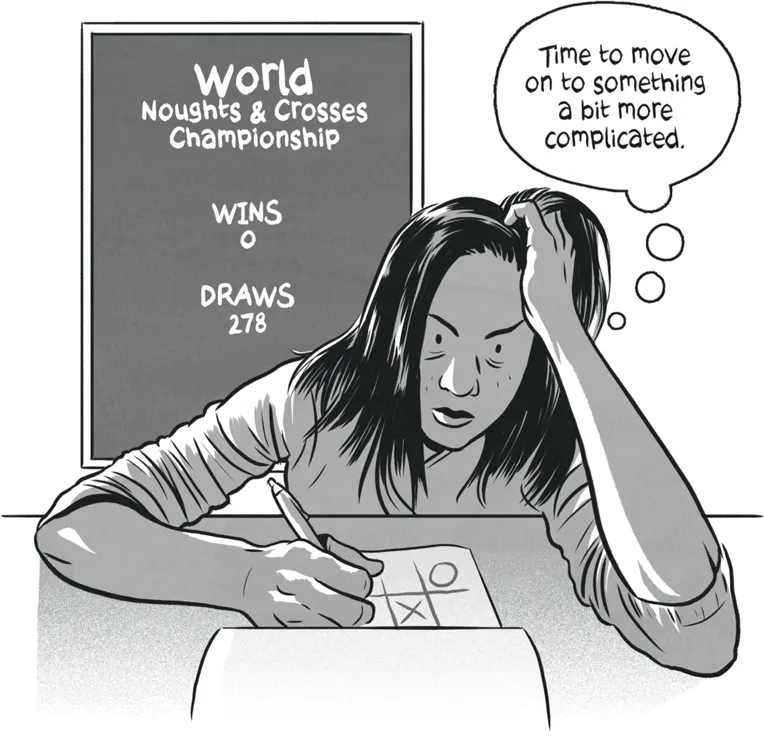
Time to move on to something a bit more complicated.
Dealing with complexity: art and science
The primary concern of game theory is not board games like chess. Rather, its aim is to improve our understanding of interactions between people, companies, countries, animals, etc., when the actual problems are too complex to fully understand.
To do this in game theory we create very simplified models, which are called games. The creation of a useful model is both a science and an art. A good model is simple enough to allow us to fully understand the incentives motivating players. At the same time, it must capture important elements of reality, which involves creative insight and judgement to determine which elements are most relevant.
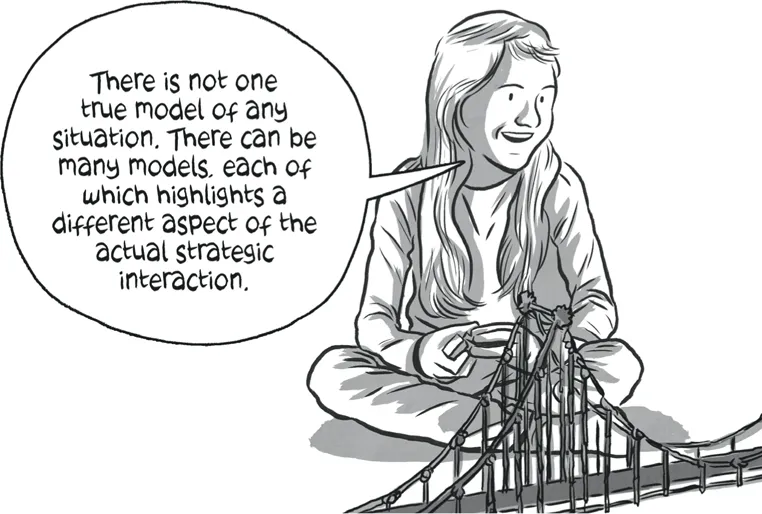
There is not one true model of any situation. There can be many models, each of which highlights a different aspect of the actual strategic interaction.
Rationality
Game theory usually assumes rationality and common knowledge of rationality. Rationality refers to players understanding the setup of the game and exercising the ability to reason.
Common knowledge of rationality is a more subtle requirement. Not only do we both have to be rational, but I have to know that you are rational. I also need a second level of knowledge: I have to know that you know that I am rational. I need a t...